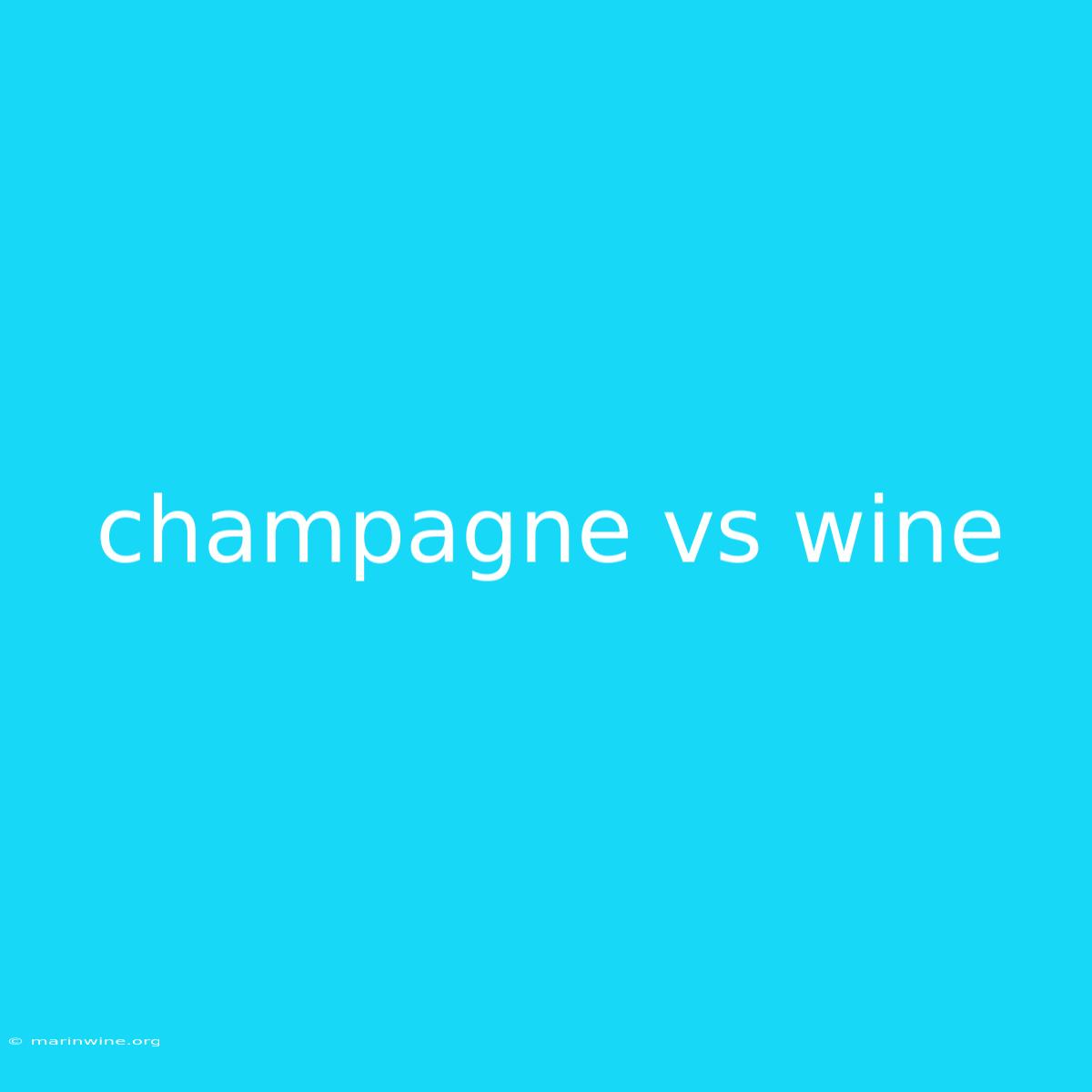Champagne vs Wine: Uncorking the Differences
Have you ever wondered what sets champagne apart from other wines? It's more than just the bubbles! Champagne is a unique and luxurious beverage with a fascinating history and specific production methods. Let's explore the world of bubbly and understand the key differences between champagne and other wines.
Why It Matters: Understanding the differences between champagne and wine can elevate your drinking experience. It allows you to make informed choices based on your taste preferences and occasion. Whether you're celebrating a special occasion or simply enjoying a glass with friends, knowing the nuances of these beverages can enhance your appreciation.
Key Takeaways of Champagne vs Wine:
| Feature | Champagne | Wine |
|---|---|---|
| Production | Made from specific grapes, using the méthode champenoise (secondary fermentation in the bottle) | Varies widely based on grape variety, region, and production methods |
| Region | Exclusively from the Champagne region in France | Produced globally in various regions |
| Taste | Typically dry, with delicate bubbles, and complex aromas | Ranges from dry to sweet, with diverse flavors and aromas depending on the grape variety and production method |
| Occasion | Special occasions, celebrations, and formal events | Everyday drinking, casual gatherings, and accompanying meals |
Champagne
Introduction: Champagne, the sparkling wine that has become synonymous with celebration, carries a distinct production process and a unique character.
Key Aspects:
- Specific Grapes: Champagne is made primarily from three grape varieties: Chardonnay, Pinot Noir, and Pinot Meunier.
- Méthode Champenoise: The hallmark of champagne production is the méthode champenoise, where a second fermentation occurs in the bottle, creating the characteristic bubbles.
- Aging: Champagne is aged for a minimum of 15 months (for non-vintage) and up to several years (for vintage) in the bottle.
- Dosage: After aging, a small amount of sugar (dosage) is added to adjust the sweetness level, ranging from brut (very dry) to doux (sweet).
The Connection Between Méthode Champenoise and Champagne: The méthode champenoise is crucial to champagne's identity. This unique process creates a complex interplay of flavors and aromas, contributing to the delicate bubbles that define the drink.
Wine
Introduction: Wine, a beverage enjoyed for centuries, encompasses a vast spectrum of styles and flavors, shaped by factors like grape variety, region, and production methods.
Key Aspects:
- Variety of Grapes: Thousands of grape varieties are used to produce wine, each imparting distinct characteristics.
- Production Methods: Wine production methods vary significantly, ranging from traditional hand-crafted techniques to modern industrial processes.
- Taste Profiles: Wine offers an incredibly diverse taste profile, from light and fruity to bold and complex.
- Regional Influences: Terroir, the unique combination of climate, soil, and geography, plays a significant role in shaping the character of wine.
The Connection Between Regional Influences and Wine: The concept of terroir highlights the importance of geography in shaping the taste of wine. Different regions offer distinct combinations of climate, soil, and sunlight, leading to unique flavor profiles.
Information Table:
| Feature | Champagne | Wine |
|---|---|---|
| Grape Variety | Chardonnay, Pinot Noir, Pinot Meunier | Over 1,000 varieties, including Cabernet Sauvignon, Merlot, Sauvignon Blanc, and Pinot Grigio |
| Production | Méthode champenoise | Varies, including red, white, rosé, sparkling, fortified |
| Sweetness | Brut (dry), Extra Brut, Sec, Demi-Sec, Doux (sweet) | Dry, off-dry, semi-sweet, sweet |
| Aging | Minimum 15 months in the bottle | Can be aged in barrels, tanks, or bottles |
| Price | Generally more expensive | Ranges from affordable to very expensive |
FAQ for Champagne vs Wine:
Q: What is the difference between champagne and sparkling wine? A: All champagne is sparkling wine, but not all sparkling wine is champagne. Champagne can only be made using the méthode champenoise in the Champagne region of France.
Q: Is champagne always dry? A: While brut champagne (very dry) is the most common, there are different sweetness levels available, ranging from dry to sweet.
Q: What are some popular wine regions? A: Some renowned wine regions include Bordeaux, Burgundy, Tuscany, Napa Valley, and Rioja.
Q: How do I choose the right wine for a meal? A: Consider the flavors of the dish and the wine's acidity, tannins, and sweetness. For example, a light red wine like Pinot Noir pairs well with chicken, while a bolder red wine like Cabernet Sauvignon complements beef.
Tips for Enjoying Champagne and Wine:
- Serving Temperature: Chill champagne to 45-50°F (7-10°C) and red wine to 60-65°F (15-18°C).
- Glassware: Use a champagne flute for champagne and a wine glass for wine.
- Food Pairings: Pair champagne with seafood, light salads, and cheeses, while wine complements a wider variety of cuisines.
Summary by Champagne vs Wine:
This exploration has unveiled the distinct characteristics of champagne and wine. From their production methods to their taste profiles, these beverages offer unique experiences. Understanding these differences allows you to make informed choices and appreciate the nuances of each, whether you're celebrating a special occasion or simply enjoying a glass with friends.
Closing Message: Next time you're choosing a beverage, consider the occasion and your taste preferences. Whether you're opting for the celebratory fizz of champagne or the diverse world of wines, enjoy the experience!

